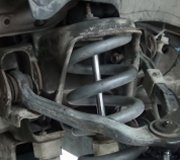Hello aaronstrand
Welcome to 2carpros
C1736 - Check the compressor Relay. It may be shorted to GND/Open Circuit
C1738 -Check exhaust Solenoid Valve, it may be shorted to GND.
One of the leading causes of compressor failure is air leaks (usually in the air springs or lines). If the compressor is constantly running, it's going to work itself to an early death.
If you're replacing a compressor, the dryer should also be changed to protect the new unit from moisture. If the dryer is saturated with moisture, it can create backpressure that can overload and burn out a compressor.
The first thing to keep in mind when servicing vehicles with electronic air suspensions is to watch out for those that are self-leveling - especially if the vehicle is going to be raised on a lift to change the tires or work on the brakes.
If you're working on a Lincoln with an electronic air suspension, there's a switch in the trunk to deactivate the system. If the system is not turned off, it will remain active after the ignition is switched off and try to level itself when the wheels are raised off the ground by venting air from the air springs. When the vehicle is then lowered back down, the suspension may go flat because there's no air in the bags.
You also want to deactivate a self-leveling suspension when doing brake or suspension work. Why? Because you don't want the suspension moving because a height sensor is telling the system module the vehicle is riding high.
Disconnecting a battery cable will also deactivate an electronic self-leveling suspension, but you'll also cut power to all the other onboard electronics. Use the deactivation switch or find and pull the fuse that powers the self-leveling control module or air compressor. Don't forget to reactive the system after the vehicle has been serviced or it may cause the warning light to come on then next time the vehicle is driven.
Another thing to keep in mind on Lincolns with full air spring suspensions is that the air springs support the weight of the chassis and are under pressure (25 psi minimum - unless the springs have gone flat). Do not vent an inflated spring or remove a spring solenoid unless the vehicle is supported on a frame contact hoist, or the chassis is supported by safety stands when the wheels are off the ground. Why? Because the chassis will drop when air is let out of the springs.
SPONSORED LINKS
Wednesday, January 13th, 2010 AT 9:14 AM



